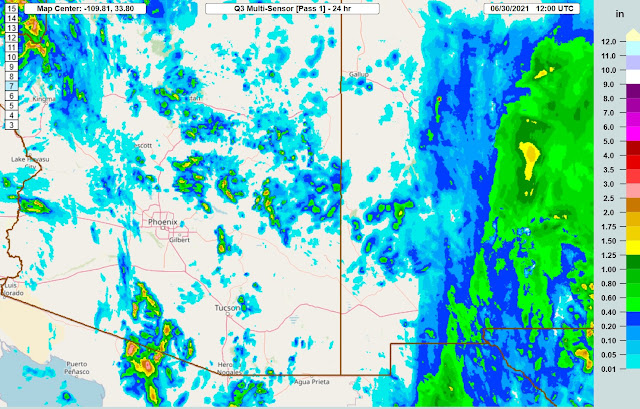It's a new season, and there have been some changes to the WRF runs. I've always had two different configurations and always wanted to avoid switching back and forth, depending on the season. I think I have found the Holy Grail, which is the MYNN PBL scheme with EDMF turned on. Also, icloud=3 was modified to increase the amount of supercooled liquid water clouds, which was seriously lacking in some situations. I've also discovered issues with soil moisture initialization errors by some of the NCEP model initializations. The Tucson and Phoenix areas can have anomalously high soil moisture, and this has been corrected.
Overview
This certainly isn't a typical monsoon pattern 500mb map as a broad trough is in place over the central CONUS and the bizarre omega block pattern over the NW CONUS. But who cares if it results in some precipitation and lower temperatures?! There is a weak mid-level cyclonic circulation over NM, resulting in widespread clouds and showers there and definitely not a typical pattern.
Moisture has increased during the past 24 hours due to moisture advection from NM and Chihuahua. PW is in the 20-25mm range over southern Arizona. The boundary of the wet air can be seen clearly from the 12Z RR initialization.
Lastly, Hurricane Enrique is approaching the southern Gulf of California, resulting in increased moisture over the Gulf. The purple-blue boundary is 38mm, blue-green is 25mm.
Model Initializations
According to satellite and upper-air data, the 700-500mb low is centered near Chihuahua City, resulting in thick clouds through most of NM. All Mexican upper-air stations reported this morning, and looking back a few days, I see this has been generally the case. Generally, the initializations are accurate, except the 12Z RR has the thick clouds initialized into far eastern Arizona, which is incorrect. 12Z PW initializations struggled as the NAM has a general 1-5mm wet bias while the RR is the opposite. 6Z NAM and GFS had minimal errors. I'm not sure the 12Z errors are large enough to impact the model forecasts, so there is no clear favorite. (maybe the 12Z GFS later?)
Day 1
Moisture continues to advect into southeastern Arizona during the morning hours but appears to be mixing out as the afternoon goes on. Despite this, enough moisture appears to be present to support some activity later today.
Combined with heating, CAPE is high enough to support storms over southeastern Arizona.
Storms form this afternoon over the higher terrain of far eastern Arizona and south of Tucson. The WRFNAM has less activity along the border than the WRFRR.
Northeasterly steering flow is favorable for storms to move off of the higher terrain of eastern Arizona into the lower elevations as the closed cyclonic circulation drifts northward towards far SW NM.
Tucson does have sufficient CAPE to support some activity. The boundary layer is also mixed deeply, so a strong outflow boundary will be sufficient to trigger storms. CAPE isn't all that great, so storms won't be that strong, except for winds, which may be strong due to the large sub-cloud mixed layer.
The various runs do have scattered storms around parts of SE Arizona, including the Tucson area, late this afternoon and into the early evening.
Phoenix has a nasty inversion at the top of the mixed layer, so, despite some CAPE, little or no activity is expected. A few showers and weak storms could form over the higher terrain just to the northeast, though.
What is likely for Phoenix is a strong outflow boundary moving across the valley from the east by late afternoon. The runs disagree on the wind speed as the WRFRR has winds around 25-30 knots, while the WRFNAM (below) is quite a bit stronger for both Tucson and Phoenix. All runs are strong enough for widespread blowing dust with the possibility of a haboob for Pinal and Maricopa Counties.
Day 2The upper-level low moves slightly to the west and are over far Southeastern Arizona by mid-day. Cooler air is present over much of central and western parts of the state, and combined with increasing moisture, more storms will be present.
Moisture advection continues from the east, and the south as a Gulf Surge gets underway, resulting in quite a bit of moisture over the state. Enrique continues to slowly weaken and moves to around southern Baja resulting in a favorable location to continue moisture advection up the Gulf of California.
While not great, CAPE is sufficient to support scattered storms over much of the state.
By mid-afternoon, scattered storms are present over the higher terrain of central Arizona. Steering flow is favorable for moving storms into the lower elevations.
All recent runs forecast scattered storms for the Phoenix area during the early evening hours.














































